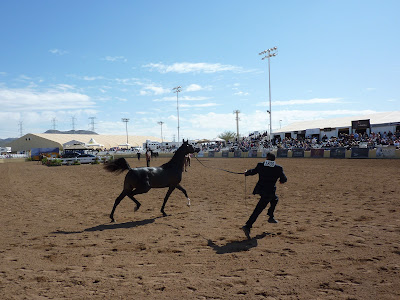
As we all know, the Arabian horse is the greatest breed of horse ever to grace humanity with its presence. This is a fact proven by science* and I love science. As a fangirl of the Arabian, the Scottsdale show was my Comicon. This is perhaps the largest Arabian horse show in the world, and it was full of the good, the bad, and the … well, Arabians are never ugly. For those of you who aren’t familiar with Arabian horses (and I pity your sad, sad souls), the Arabian is the oldest breed of horse (the breed goes back nearly 4,000 years). Originally bred by the Bedouins, these horses are known for their stamina, heat tolerance, intelligence, beauty, and loyalty to people. The Arabian is also one of the most easily identifiable horses with its high-set tail, dished head, large nostrils, arched neck, and short back. Their faces are expressive; their eyes are large and dark. Because the Arabian horse was so important to Bedouin war and life, it was regarded with the highest honor and respect. With the arrival of Islam, the Arabian horse gained status as a gift from God.
Now back to Scottsdale. Some of the classes I got to watch were Reining, English Pleasure, Hunter, Native Costume, Halter, Liberty, Dressage, and Sport Horse in Hand. Because I was only there for two days, I missed a lot (the show lasts for two weeks). Nevertheless, I learned a lot.
General Observations: Overall, I had a great time. The horses were gorgeous and in wonderful condition. Westworld, where the show was held, was spectacular. It is a HUGE facility. Even so, the show was crowded. It was nice to see so many non-Arabian horse people too. The competitors and barn representatives were a tight-lipped group that didn’t exude hospitality (the exception was Sheila Varian, of Varian Arabians, who is an equestrian Saint and High Priestess of Awesome). I was a bit disappointed that people weren’t as warm to visitors. I can’t really blame these people though, I mean, showing horses is stressful. On a philosophical note, I’m worried that the breed is getting too niche-oriented; halter horses only do halter, western horses only do western, etc. We are starting to see a major phenotypical divergence between say, park horses (who are starting to resemble Saddlebreds) and halter horses (who look like the offspring of angels and swans). One of the reasons I love the Arabian breed so much is that it can rock the performance world while still looking good. I just hope we can keep that up. A halter horse that can’t be ridden is almost useless; a park horse that moves, acts, and looks like a Saddlebred is…a Saddlebred with an Arabian pedigree.
 |
| Halter stance...but I liked this stallion. He didn't win... |
Individual Classes: I didn’t get to see much dressage, reining or hunter, but what I did see was enjoyable. I found the English pleasure and park type classes to be fascinating, but I’m not too familiar with this style of riding to pass any judgments. It looked like people in tuxedos and bowler hats were riding horse-shaped rockets. Native costume was super fun to watch, definitely a crowd-pleaser. Liberty (where they let the horse loose in the arena for two minutes and watch it run around to music) was also popular, although I think the wrong horse won. Sport horse in-hand was really neat. I got to see the purebred gelding class compete and I found these horses to be of very high caliber. This class is a bit like halter, but focuses more on traditional sport horse movement (hunter, dressage, etc.) and sound conformation. The horses are presented in English bridles with their manes and tails braided. It is lower-energy than the “regular” halter classes, but I was impressed by the horses. Overall, they were solid, athletic horses who managed to keep Arabian “type.” The Sport horse handlers were also a bit more conversational. As for “regular” halter, I have a love/hate relationship with the event. I love how much energy and exuberance it exhibits. I hate how much rough handling went on and how much politics played a role in the rankings. By “rough handling,” I mean constant yanking on the lead rope and threatening with the whip. A number of the horses (yearlings especially) looked tense and frightened. Any incorrect movement, such as breaking into a canter or having the incorrect stance during lineup, would bring a crank on the lead and a snap on the back legs with the whip. I do not think this shows the breed in the best light. Outsiders don’t understand what’s going on or what the judges are looking for. A number of spectators asked me about judging criteria because they had NO IDEA based on what they were watching. And this is where politics comes in. To be fair, I can understand that the Big Name Trainers are going to get the Big Name Horses. This makes sense. But there is something amiss when I can name the top three places in any halter class based solely on who holds the lead line. Give me a list of the handlers/trainers and I’ll tell you which horses are going to place…I don’t need to see the horses. Okay, rant from the peanut gallery is over, time for pictures!
 |
| Native Costume |
 |
| I could'a been a contender. |
 |
| Halter Action |
 |
The crowd favorite.
Won his class and got Reserve Champion for Junior Stallions. |
 |
| Nothing says "Arabian Horse Show" like an owl. |
 |
| Yearling Halter |
 |
Driving
|
 |
| The Boggs himself. One of the top 3 halter trainers |
 |
| Sport Horse. This handler lady was nice to me. |
 |
| Liberty |
 |
Half-Arab Native Costume
|



































